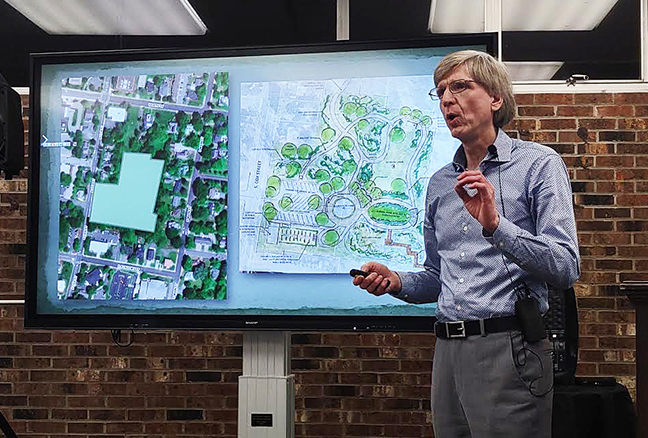Welcome!

Ross Holt, director of the Randolph County Public Library system, gives a talk on the history of the proposed Center City Garden. Larry Penkava / Randolph Hub
Center City Garden once known as ‘Lawn of Asheboro’
ASHEBORO — The property set to become the David and Pauline Jarrell Center City Garden has a history going back to Asheboro’s favorite son.
In a historical presentation on Jan. 23 at the Asheboro Public Library, Ross Holt, director of the Randolph County Public Library system, gave a lecture, “From Worth Farm to Center City Garden: The Evolution of the Lawn of Asheboro.”
His talk was supplemented by a large screen that showed names and faces of those involved in the property as well as maps of the area defined by Worth, Cox, Academy and Main streets.
Holt affirmed the significance of the location with a story.
When Sidney Swaim Robbins was a boy, he awoke one night in 1886 to discover the house across the street on fire. He woke up his brother and said they were witnessing “a landmark going down.”
It had been the home of Jonathan Worth, governor of North Carolina from 1866-68. Even 17 years after Worth’s death, his former home was still considered legendary.
That rectangle formed by Worth, Cox, Academy and Main streets had been known as the Worth Farm. When Jonathan Worth left Asheboro for Raleigh to serve in the state government and later as governor during Reconstruction, locals “viewed the farm as a special place,” Holt said. “That’s reason enough to be the David and Pauline Jarrell Center City Garden.”
A lawyer, Samuel Bradshaw, bought the property to develop the land into several tracts. Ross said an entry in a Register of Deeds document called the site part of the “Lawn of Asheboro.”
Holt then went on to show how the history of the property “wove in and out of three influential families” — the Worths, the Walkers and the Moffitts.
Jonathan Worth had been a leading citizen in the city and state even before the Civil War. He studied law under Archibald D. Murphey, an advocate of public education, and married Murphey’s niece.
When Worth bought the farm in the county seat, there was one, perhaps two, law offices in the northeast corner near the Randolph County courthouse, which was on Salisbury Street near Main Street.
Worth was a lawyer but also had business interests, buying and selling land. He was also active in politics and served in the Legislature. He wrote the law to establish a state public school system.
When Worth moved to Raleigh and sold his 10-acre farm, there were 200 trees, many fruit-bearing, three acres of meadow and a number of buildings beside the house. Worth and his wife had six daughters and one son.
One of Worth’s daughters, Elvira, married, in order, Samuel S. Jackson, Samuel J. Walker and Eli Needham Moffitt, all of whom left her a widow. Worth had sold the property to Jackson.
Bradshaw bought the land in 1886 with the intent to subdivide it for development. He sold lots to Elijah Moffitt, P.H. Morris and Eugene Morris. Moffitt built a house on Worth Street, which was bought by D.B. McCrary, founder of McCrary Hosiery, and later B.B. Walker, who built the shoe factory that held his name. That building on Dixie Drive is currently being demolished The house he bought from D.B. McCrary is now under renovation.
McCrary’s sons, Charles and Frank, also built homes on Worth Street. All the McCrary homes are listed as Randolph County historic landmarks.
The Worth, Moffitt and Walker families, as well as the properties they lived on, were all instrumental in the development of Asheboro, from farming to industrialization to manufacturing. The “Lawn of Asheboro” has been owned by five mayors, six including David Jarrell, who with his wife Pauline donated a good portion of the future Center City Garden to the City of Asheboro.
Holt said, “It’s fitting that this will be the ‘Lawn of Asheboro.’ ”
•••
On Thursday, Feb. 23, from 5-6:30 p.m.,there will be an informal drop-in public workshop at the Asheboro Public Library, 200 Worth St., providing an update on the Center City Garden project.
Then on Saturday, April 29, from 10 a.m.-3 p.m., there will be a Center City Garden groundbreaking and garden cleanup at the property.
